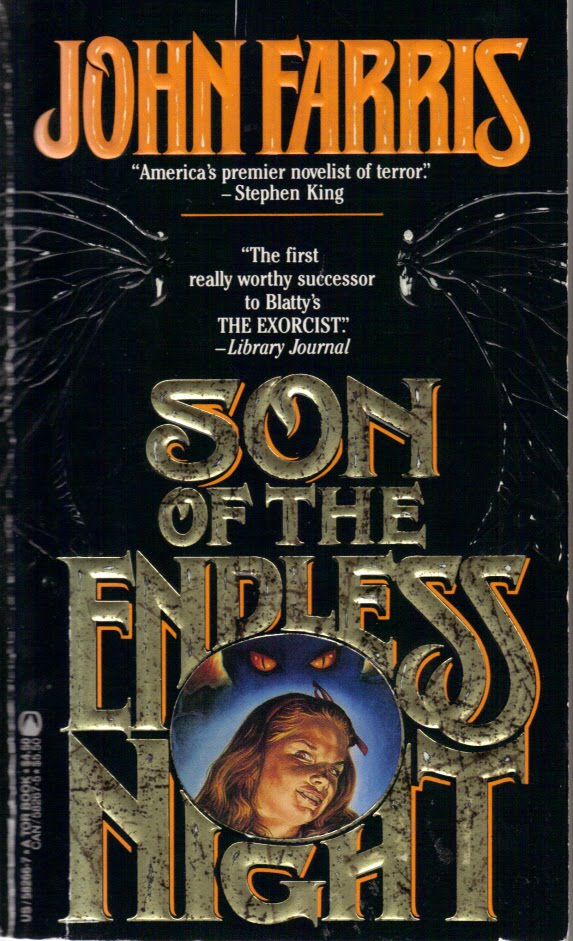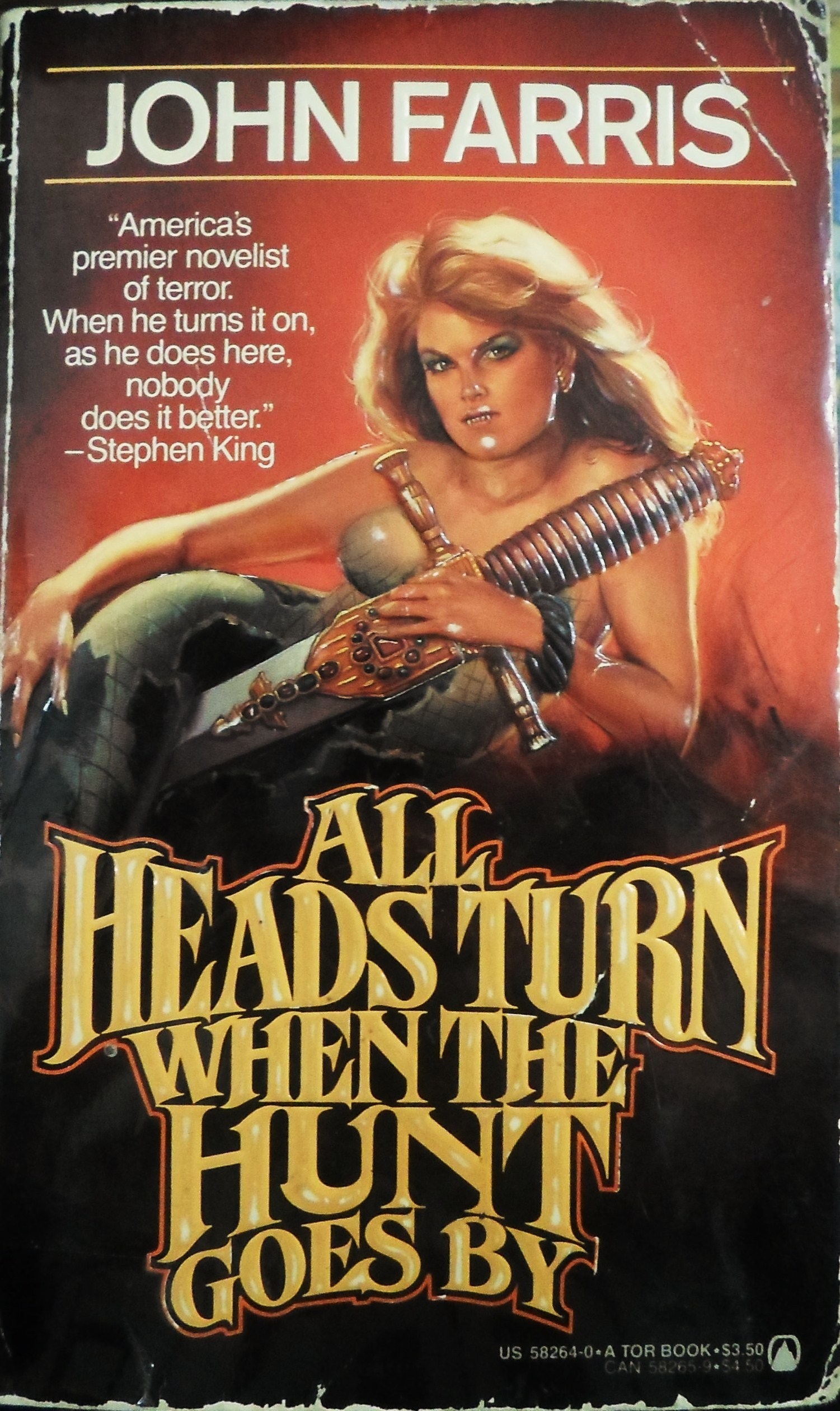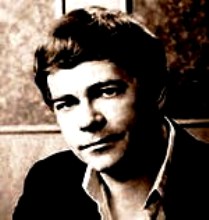It’s Friday the 13th, so Grady Hendrix, author of Horrorstör, and Will Errickson of Too Much Horror Fiction are back to uncover the best (and worst) horror paperbacks.
Although his name doesn’t have the brand-familiarity of a King or a Koontz, horror/suspense author John Farris (b. 1936, Missouri) had one of the great runs of horror novels throughout the 1980s. He’d first been getting published way back in the late 1950s, writing pulpy thrillers and having success with the “high school confidential” novels Harrison High and its several sequels, but it was his 1976 book The Fury that was his largest mainstream success, as it was also turned into a film by Brian DePalma most notable for its stunningly tasteless, literally explosive bit of gory FX for its climax.
After that you can bet Farris was branded a “horror writer” as the genre began its publishing boom in the early ’80s. The paperback editions of his novels, both new and old, were marketed with some of the most lurid cover art of the era. Competition was fierce! Most were published/republished by Tor under their horror imprint and they did a fantastic job with these gaudy images, so intricately macabre and irresistibly evil (thanks to artists like John Melo and Joe DeVito). Behold, the covers for The Fury, The Uninvited, Wildwood, Nightfall, The Captors, Sharp Practice…
 On the surface, then, Farris’s novels seem to promise fast, cheap, sub-literate thrills; mindless trash horror fiction for the undiscerning reader. But that impression would be wrong! The thing is this: Farris can write. Aside from the bone-crushing moments of horror rendered by a pen that does not flinch from describing, there are scenes of real humanity—of life and love and sex and work and money and God and law, of characters who have the heft and believability that comes from years of lived experience. Farris has the ability to capture the world people actually live in, which then makes his supernatural terrors all the more convincing. I can’t tell you the many horror novels I’ve read in which I wonder if the author has ever, like, met and spoken with another human person in the flesh! I can be unforgiving like that, especially when a writer like Farris goes overlooked while those with vastly lesser talents gain fanboys who froth over each lunkheaded line of prose and unbelievable motivation.
On the surface, then, Farris’s novels seem to promise fast, cheap, sub-literate thrills; mindless trash horror fiction for the undiscerning reader. But that impression would be wrong! The thing is this: Farris can write. Aside from the bone-crushing moments of horror rendered by a pen that does not flinch from describing, there are scenes of real humanity—of life and love and sex and work and money and God and law, of characters who have the heft and believability that comes from years of lived experience. Farris has the ability to capture the world people actually live in, which then makes his supernatural terrors all the more convincing. I can’t tell you the many horror novels I’ve read in which I wonder if the author has ever, like, met and spoken with another human person in the flesh! I can be unforgiving like that, especially when a writer like Farris goes overlooked while those with vastly lesser talents gain fanboys who froth over each lunkheaded line of prose and unbelievable motivation.
The obvious problem is of course that readers who would appreciate Farris’s mature style would probably never deign to pick up such a demonically decorated paperback as 1986’s Son of the Endless Night. Oh well, their loss! The die-cut image is that of an evilly leering pubescent girl—a go-to cliché of horror post Exorcist/Carrie/Audrey Rose—while the stepback art is either worse or better, depending on your taste.
Artist John Melo’s precisely-rendered winged devil burns bright with hate and malevolence, and when it comes to precisely-rendered bat wings, I’m a complete sucker. Endless Night is just one big bad-ass horror/thriller novel, near-epic in its scope, bold, brash, smart, and fearless.

A young woman named Karyn Vale is murdered on a skiing vacation in Vermont by her boyfriend, Richard Devon, in front of a handful of witnesses who are frozen to the spot by the sheer violent intensity of the attack. Using a tire iron, Rich pulverizes the poor woman (“She did not think about dying; instead she was suffocated by feelings of betrayal and grief”) beyond recognition. The community is horrified, but from jail Richard tearfully insists to his half brother, Conor Devon, that he wasn’t in control of himself when the murder occurred, that he was not in possession of his body or his mind. Rich insists to Conor that he was only trying to help 12-year-old Polly Windross, who Rich believes was being held captive and abused by a Satanic cult, her father a member. Rich tried to rescue her, failed, then led the police back to the place she was being held, to find—nothing whatsoever. The purported leader of this cult, a mysterious, scarred woman named Inez Cordway, with whom Rich shared a bizarre and hallucinatory evening, has now seemingly disappeared.
At hand is that hoary old standby of horror fiction, demonic possession. Fortunately Conor was once a priest, although he gave it up to become, of all things, a semi-professional wrestler (definitely not a hoary old standby) called Irish Bob O’Hooligan, working on the fringes of the so-called sport, drinking a bit more than he should, hurting a bit more than he wants. Now into Conor’s not-so-perfect family life comes an opportunity to help his beloved half brother. Convinced of Rich’s innocence, Conor starts asking old seminary pals who are now bona fide priests themselves just what they know about exorcism and how in the modern world one goes about getting one (“Who were you expecting? Max Von Sydow?”). Meanwhile, Rich’s young, ambitious defense attorneys are gearing up for the insanity plea, as Tommie Horatio Harkrider, a famous lion-maned criminal lawyer, is hired by Karyn’s rich society parents for the prosecution. None of them, rational and reasonable to a fault, have any idea what’s coming. Surely the legal world is not equipped for a “not guilty by reason of demonic possession” defense? Well, people get ready!
Farris’s knack for apt and earthy physical descriptions of people is more like that of, say, a Robertson Davies than most other horror novelist’s. One character’s skin tone is “the color of day-old hollandaise,” another has a Southern accent “hock-deep in hominy grits,” still another’s face has the “frosty radiance of a new penny, flaring to red along the taut bonelines.” And the sex? Yeah, plenty of graphic sex (some of it really inappropriate in that 1980s way too)! It’s graphic, yet human, in that Farris captures the carnal thoughts that flit through our minds, as well as the intimate pleasures and pains of the act itself. But not all of Endless Night is about humanity; indeed, Farris also excels at envisioning a demonic presence, a chaos of fire and death and insanity, “of untreated wounds and charred flesh, of black vomit and cesspools and mass open graves. Of a world totally corrupt, ravaged and dead as it hurtled one last time around the sun.” During an occult ritual into which Rich has been tricked into participating:
And another face appeared where Polly’s had been, as the thing in the air continued to hover, part bird, part bat, part of something else from the dim beginnings of earth, seen lurching through grimy skies by the light of erupting volcanoes. Mad darting eyes as red as pared flesh, a hundred sharp teeth in a beak that belong on a crocodile, the breast of it leathery but teated like a woman’s, it craned to gaze at Rich and rowed the air with sharp-framed wings.
With all its intermingled characters, hints at class struggle, scenes of epic terror and violence, courtroom theatrics, and the skilled dramatic unspooling of such a large canvas of events, Endless Night is a captivating work. While it veers close to a sort of Catholic apologia in the climax—similar perhaps to the deus ex machina of The Stand (1978)—I still found the novel utterly engaging, the kind you simply devour over a weekend, ignoring all else. Sure, there are some tasteless, ridiculous moments here and there (Conor’s devout Catholic wife Gina finds herself battling evil forces with broadly-drawn Southern fundamentalists) but that’s just what horror fiction fans want, right? Soon as we see that paperback cover art, we know what we’re in for, or at least what we hope we’re in for, and Son of the Endless Night gives it to us straight, no chaser.
 Another of my favorite Farris novels is 1977’s All Heads Turn When the Hunt Goes By (reprinted by Tor in 1986 with cover art by Joe DeVito). Despite its enigmatic title which is never quite explained, this is mainstream bestselling horror at its finest: wholly entertaining and gripping, a horror fiction mélange of the classic adventure tale, multi-generational family saga, swampy Southern Gothic, and even the horribly-dated and definitely politically-incorrect “plantation novel,” all to stunning, unforgettable effect (indeed David J. Schow chose it as his entry in Horror: 100 Best Books).
Another of my favorite Farris novels is 1977’s All Heads Turn When the Hunt Goes By (reprinted by Tor in 1986 with cover art by Joe DeVito). Despite its enigmatic title which is never quite explained, this is mainstream bestselling horror at its finest: wholly entertaining and gripping, a horror fiction mélange of the classic adventure tale, multi-generational family saga, swampy Southern Gothic, and even the horribly-dated and definitely politically-incorrect “plantation novel,” all to stunning, unforgettable effect (indeed David J. Schow chose it as his entry in Horror: 100 Best Books).
Writing in his smooth and assured style, Farris settles in, moving his tale along and taking the reader with him. Here his prose is impressionistic at times, once the delirium of horror and bloodshed begin; other times it is all too clear-eyed. The horror starts just a few pages in, as the story careens out of the gate with a military wedding ceremony in Virginia that descends into an unimaginable bloody tragedy. Hot damn! You’ve never been to a wedding like this:
A flick of [the groom’s] wrist and slight thrust and the level blade went through [the bride’s] veil and the column of her throat inches beneath her raised chin. Then the veil behind her head filled as if inflated by a gust of air, a backward breath, and I saw the elegant tip of the wetted blade holding the veil away from her nape for an instant… The long arc of the saber sheared Boss at the neckline and his expression was still puzzled, the blighted eye squinted almost shut, as his head bounded onto a pew seat (a horror so extreme I refused to acknowledge that it could have happened).
Set during World War II, Farris has threaded together the fates of two great families, one from the States and one from England. The Bradwins are one of those wealthy Southern families made by generations of virile military men—and their servants barely more than slaves—plagued by arrogance, entitlement, brilliance, lechery, and charm in maddeningly equal measures. The Holleys are a British family who travel to Africa to administer health care to the remotest regions of that continent. Their tragic back-stories are the most richly imagined parts of the book. The families are linked by the beautiful Nhora, a woman who, as a child, was kidnapped by a cannibalistic African tribe beholden to the superstitions of voodoo, that twining tight of the Christianity of the west and the native beliefs of Africa. So cultural imperialism figures large, the privilege and entitlement that people can feel when dealing with others they think may be beneath them, even when the others are members of one’s own family. But all people are weakened by fear and greed and superstition—especially when that superstition turns out to be the truth.
Farris is successful both in concept and execution in All Heads Turn. From the endless tormenting rains in the wilds of Africa to the sultry evenings on a Southern plantation, from a near-madhouse in the English countryside to the hideous visions of symbolic dementia, Farris never falters in bringing it all to palpable life. Characters, even minor ones (the fingernail-less bomb expert Luxton; self-regarding patriarch Boss Bradwin; Boss’s illegitimate half-black highly educated son Tyrone), arrive fully-formed even if flawed or broken—especially if flawed or broken. Farris’s evocation of the supernatural, a heady Freudian nightmare of myth, monsters, and magic, is wonderfully tasteless, primeval, and exotic; his depiction of fathers and sons beleaguered by ego and ignorance, heartfelt and honest. The attentive reader will notice an aside to several writers and poets (Haggard, Keats, Ovid) that explains much. And if some readers find this hotted-up stew gets wrapped up a mite quickly, then I have to say I prefer that to an ending that goes on for 50, 75, 100 pages and exhausts the reader’s patience (I’m looking at you, King and Straub!). Farris bring his story to a screeching shuddering sudden halt at the climax, a climax that speaks of the truly poisonous nature of obsession, desire, and fear.
For lovers of vintage horror fiction paperbacks, their cover art and their contents, the novels of John Farris offer delights aplenty: from the unforgettable cover art that demand a browser pick it up and buy it now, to the accomplished storytelling within that both enlightens and terrifies, these are horror novels that stand with the best of that era, that wild and wooly decade known as the 1980s.
Will Errickson covers horror from the ’60s, ’70s, and ’80s on his blog Too Much Horror Fiction.











I’ve read quite a few John Farris novels and the run from terrible to very fine horror. But Farris’ PHANTOM NIGHTS stands tall among the best literture of the 21st century. I highly recommend it.
ALL HEADS TURN WHEN THE HUNT GOES BY was reprinted in a fine limited edition by Centipede Press a couple of years ago. I think copies are still available from the publisher.
@3 Really? I’ve been meaning to acquire it since I read Horror: The Best 100 Books…
For me Mr. Farris is hit or miss. He can write some fantastic stuff, such as the Fury or really, really horrible novels such as Son of the Endless Night. “Son” was one of the worst novels I have ever read. Started off OK, but went straight over the falls at about the halfway mark.
ALL HEADS TURN AS THE HUNT GOES BY is one of those titles I wish I’d thought of. I remember it from seeing it on the book as a teen.
Fell through the rabbit hole–or possibly a worm hole–to this site. I’ve read Ferris’ stuff to rags over the years. As good of a writer as Michael McDowell, another southerner, in my opinion. Sadly unappreciated, but this is one author who didn’t rush to sacrifice his humanity in exchange for divinity. Those who appreciate fine writing will still remember him when he goes. So he wins anyway.